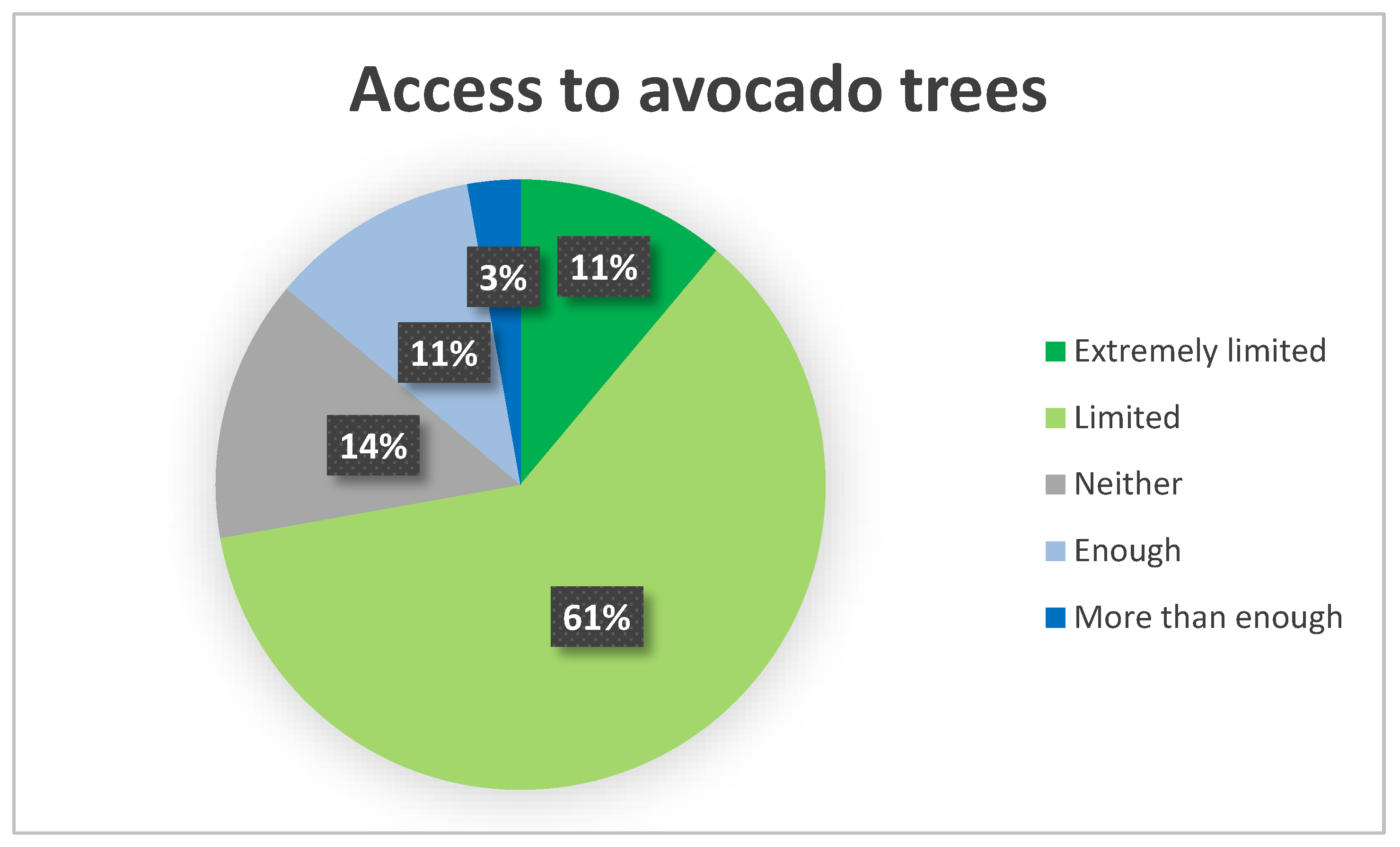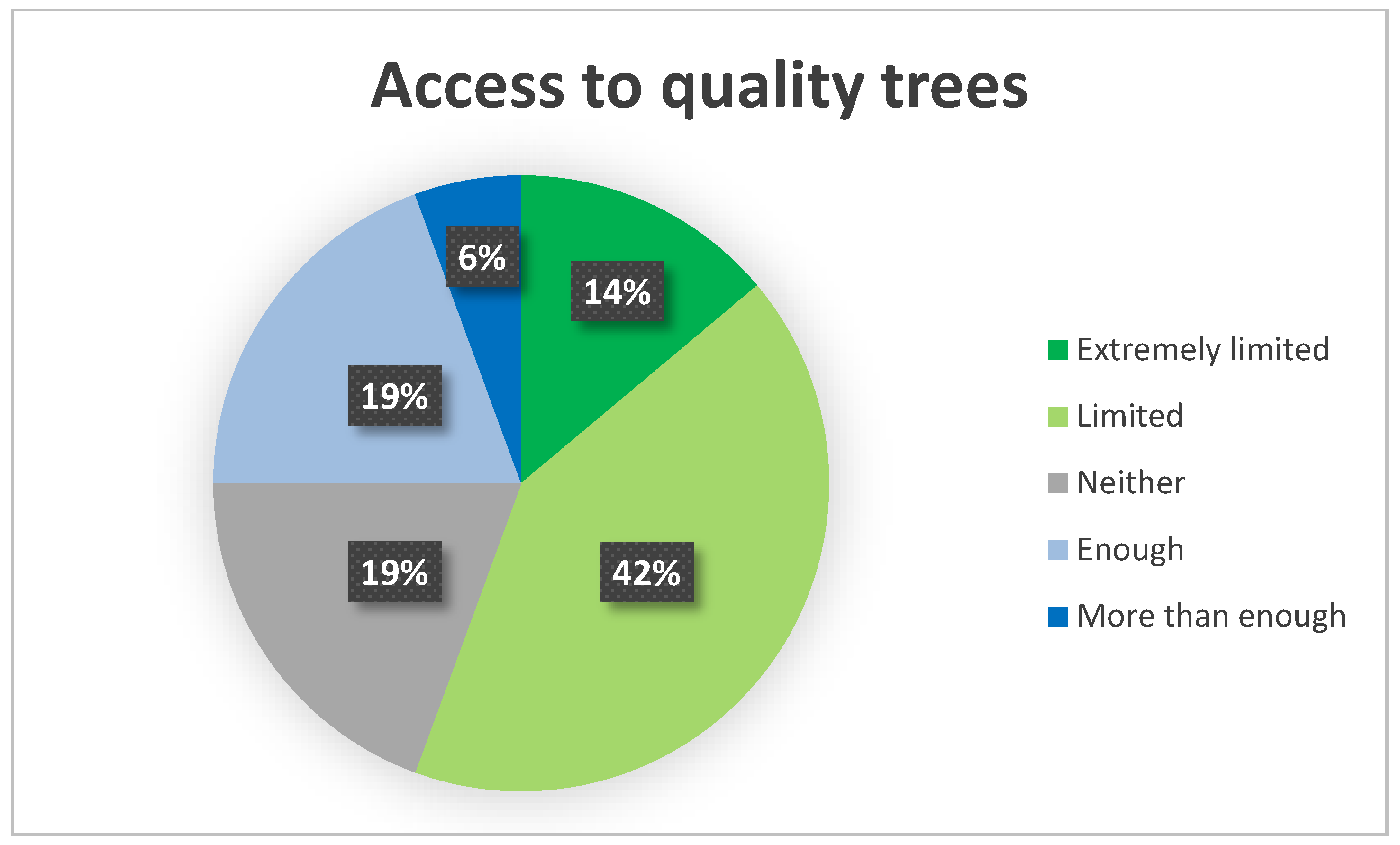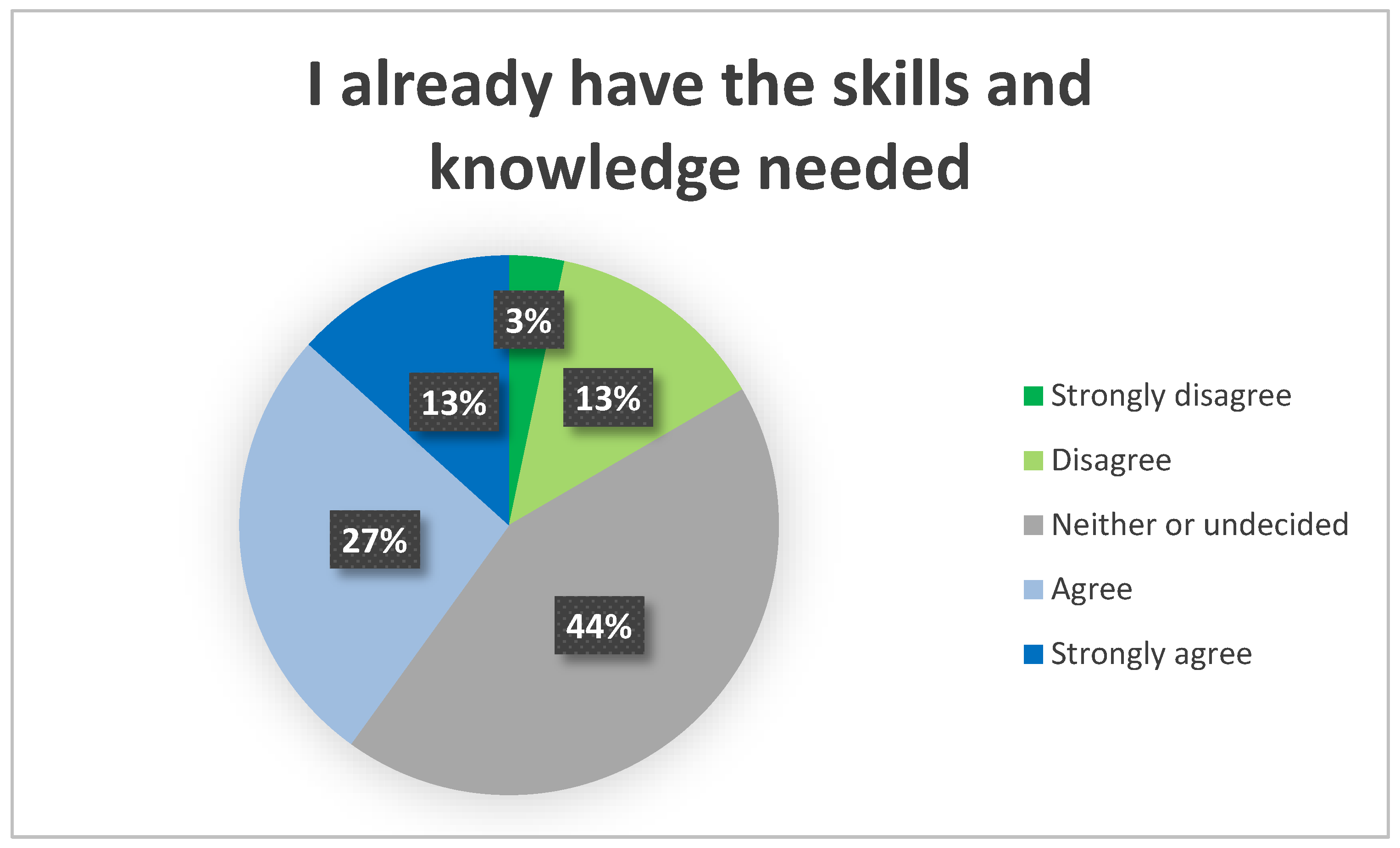Perceptual Factors Influencing the Adoption of Innovative Tissue Culture Technology by the Australian Avocado Industry
Abstract
:1. Introduction
Technology Adoption
2. Materials and Methods
2.1. Design
2.2. Recruitment and Sampling
2.3. Participants
2.4. Analysis
3. Results
3.1. Current Industry Sentiment and Job Relevance of Tissue Culture
3.2. Output Quality and Result Demonstrability
3.3. Perceived Usefulness of Tissue Culture
3.4. Perceived Ease of Use of Tissue Culture
3.5. Perception of Tissue Culture Knowledge and Skills Required, Subjective Norms, and Intention to Use
4. Discussion
4.1. Age, Experience, and Location
4.2. Perception and Acceptance of Tissue Culture Technology
4.3. Strengths and Limitations
5. Conclusions
Author Contributions
Funding
Institutional Review Board Statement
Informed Consent Statement
Data Availability Statement
Conflicts of Interest
References
- Avocados Australia. Facts at a Glance 2020/21 for the Australian Avocado Industry; Key Statistics of the Australian Avocado Industry; Hort Innovation: Brisbane, QLD, Australia, 2021; Available online: https://avocado.org.au/wp-content/uploads/2021/10/2020-21_AAL-Facts-at-a-glance2.pdf (accessed on 18 December 2021).
- Department of Agriculture, Water and the Environment. Avocados from Chile. Available online: https://www.awe.gov.au/biosecurity-trade/policy/risk-analysis/plant/avocado-from-chile (accessed on 30 June 2021).
- Hiti-Bandaralage, J.C.A.; Hayward, A.; Mitter, N. Micropropagation of Avocado (Persea Americana Mill.). Am. J. Plant Sci. 2017, 8, 2898–2921. [Google Scholar] [CrossRef] [Green Version]
- Hughes, M. Avocado Tree Wait Times Smashed Thanks to World-First Rootstock Trial. ABC News, 6 June 2021. Available online: https://www.abc.net.au/news/rural/2021-06-07/innovation-smashes-avocado-wait-times/100184924(accessed on 28 January 2021).
- Silva, T.A.; Ledesma, N. Avocado history, biodiversity and production. In Sustainable Horticultural Systems: Issues, Technology and Innovation; Nandwani, D., Ed.; Springer International Publishing: Cham, Switzerland, 2014; pp. 157–205. [Google Scholar]
- Best, T.; Thorne, H.; Axtens, J.; Gleeson, M.; Hiti-Bandaralage, J.; Hayward, A.; Mohsin, M.; Ng, E.; Zull, A.; Slaughter, G.; et al. Tissue Culture for Australian Avocados: Project Information Pack; Central Queensland University: Brisbane, QLD, Australia, 2021. [Google Scholar]
- Hiti-Bandalarage, J.; Hayward, A.; O’Brien, C.; Mitter, N. Micropropagation: The Future of Clonal Propagation of Avocado. In Proceedings of the TropAg: International Tropical Agriculture Conference, Brisbane, Australia, 20–22 November 2017. [Google Scholar]
- Suman, S. Plant Tissue Culture: A Promising Tool of Quality Material Production with Special Reference to Micropropagation of Banana. Biochem. Cell. Arch. 2017, 17, 1–26. [Google Scholar]
- Pathak, H.S.; Brown, P.; Best, T. A Systematic Literature Review of the Factors Affecting the Precision Agriculture Adoption Process. Precis. Agric. 2019, 20, 1292–1316. [Google Scholar] [CrossRef]
- Umbers, A.; Watson, P.; Watson, D. Farm Practices Survey Report 2015; Grains Research & Development Corporation: Toowoomba, Australia, 2016. [Google Scholar]
- King, A. Technology: The Future of Agriculture. Nature 2017, 544, S21–S23. [Google Scholar] [CrossRef] [PubMed] [Green Version]
- Fuglie, K.O.; Kascak, C.A. Adoption and Diffusion of Natural-Resource-Conserving Agricultural Technology. Rev. Agric. Econ. 2001, 23, 386–403. [Google Scholar] [CrossRef]
- Lambert, D.M.; Paudel, K.P.; Larson, J.A. Bundled Adoption of Precision Agriculture Technologies by Cotton Producers. J. Agric. Resour. Econ. 2015, 40, 325–345. [Google Scholar] [CrossRef]
- Tey, Y.S.; Brindal, M. Factors Influencing the Adoption of Precision Agricultural Technologies: A Review for Policy Implications. Precis. Agric. 2012, 13, 713–730. [Google Scholar] [CrossRef]
- Ambali, O.I.; Areal, F.J.; Georgantzis, N. Improved Rice Technology Adoption: The Role of Spatially-Dependent Risk Preference. Agriculture 2021, 11, 691. [Google Scholar] [CrossRef]
- Barham, B.L.; Chavas, J.-P.; Fitz, D.; Salas, V.R.; Schechter, L. The Roles of Risk and Ambiguity in Technology Adoption. J. Econ. Behav. Organ. 2014, 97, 204–218. [Google Scholar] [CrossRef]
- Venkatesh, V.; Davis, F.D. A Theoretical Extension of the Technology Acceptance Model: Four Longitudinal Field Studies. Manag. Sci. 2000, 46, 186–204. [Google Scholar] [CrossRef] [Green Version]
- Douthwaite, B.; Hoffecker, E. Towards a Complexity-Aware Theory of Change for Participatory Research Programs Working within Agricultural Innovation Systems. Agric. Syst. 2017, 155, 88–102. [Google Scholar] [CrossRef]
- Mottaleb, K.A. Perception and Adoption of a New Agricultural Technology: Evidence from a Developing Country. Technol. Soc. 2018, 55, 126–135. [Google Scholar] [CrossRef] [PubMed]
- Michler, J.D.; Tjernström, E.; Verkaart, S.; Mausch, K. Money Matters: The Role of Yields and Profits in Agricultural Technology Adoption. Am. J. Agric. Econ. 2019, 101, 710–731. [Google Scholar] [CrossRef]
- Pierpaoli, E.; Carli, G.; Pignatti, E.; Canavari, M. Drivers of Precision Agriculture Technologies Adoption: A Literature Review. Procedia Technol. 2013, 8, 61–69. [Google Scholar] [CrossRef] [Green Version]
- Kuehne, G.; Llewellyn, R.; Pannell, D.J.; Wilkinson, R.; Dolling, P.; Ouzman, J.; Ewing, M. Predicting Farmer Uptake of New Agricultural Practices: A Tool for Research, Extension and Policy. Agric. Syst. 2017, 156, 115–125. [Google Scholar] [CrossRef]
- Ratchford, M.; Barnhart, M. Development and Validation of the Technology Adoption Propensity (TAP) Index. J. Bus. Res. 2012, 65, 1209–1215. [Google Scholar] [CrossRef] [Green Version]
- Legris, P.; Ingham, J.; Collerette, P. Why Do People Use Information Technology? A Critical Review of the Technology Acceptance Model. Inf. Manag. 2003, 40, 191–204. [Google Scholar] [CrossRef]
- Avocados Australia. Export Development. 2019. Available online: https://www.avocado.org.au/our-programs/export-development/ (accessed on 30 August 2020).
- D’Souza, G.; Cyphers, D.; Phipps, T. Factors Affecting the Adoption of Sustainable Agricultural Practices. Agric. Resour. Econ. Rev. 1993, 22, 159–165. [Google Scholar] [CrossRef] [Green Version]
- Paxton, K.W.; Mishra, A.K.; Chintawar, S.; Roberts, R.K.; Larson, J.A.; English, B.C.; Lambert, D.M.; Marra, M.C.; Larkin, S.L.; Reeves, J.M.; et al. Intensity of Precision Agriculture Technology Adoption by Cotton Producers. Agric. Resour. Econ. Rev. 2011, 40, 133–144. [Google Scholar] [CrossRef]
- Slatton, R.; Orr, B. A Smorgasbord of Agricultural Technologies: Farmers’ Choices and Lessons from Chalite, Panama. Dev. Pract. 2008, 18, 125–130. [Google Scholar] [CrossRef]
- Vecchio, Y.; De Rosa, M.; Adinolfi, F.; Bartoli, L.; Masi, M. Adoption of Precision Farming Tools: A Context-Related Analysis. Land Use Policy 2020, 94, 104481. [Google Scholar] [CrossRef]
- Chavas, J.-P.; Nauges, C. Uncertainty, Learning, and Technology Adoption in Agriculture. Appl. Econ. Perspect. Policy 2020, 42, 42–53. [Google Scholar] [CrossRef] [Green Version]
- Kathage, J.; Kassie, M.; Shiferaw, B.; Qaim, M. Big Constraints or Small Returns? Explaining Nonadoption of Hybrid Maize in Tanzania. Appl. Econ. Perspect. Policy 2016, 38, 113–131. [Google Scholar] [CrossRef] [Green Version]
- Keogh, M.; Tomlinson, A.; Potard, G. Recent Trends in Farm Finance and Rural Debt in Australia. Farm Policy J. 2013, 10, 1–11. [Google Scholar]
- Alston, M.; Whittenbury, K. Climate Change and Water Policy in Australia’s Irrigation Areas: A Lost Opportunity for a Partnership Model of Governance. Env. Polit. 2011, 20, 899–917. [Google Scholar] [CrossRef]
- McKenzie, F. Farmer-Driven Innovation in New South Wales, Australia. Aust. Geogr. 2013, 44, 81–95. [Google Scholar] [CrossRef]
- Mayoux, L. Quantitative, Qualitative or Participatory? Which Method, for What and When. In Doing Development Research; Desai, V., Potter, R., Eds.; Sage Publications: London, UK, 2006; Volume 1, pp. 115–129. ISBN 10-1-4129-0284-3. [Google Scholar]
- Mitter, H.; Larcher, M.; Schönhart, M.; Stöttinger, M.; Schmid, E. Exploring Farmers’ Climate Change Perceptions and Adaptation Intentions: Empirical Evidence from Austria. Environ. Manag. 2019, 63, 804–821. [Google Scholar] [CrossRef] [Green Version]
- Koech, R.; Haase, M.; Grima, B.; Taylor, B. Barriers and Measures to Improve Adoption of Irrigation Technologies: A Case Study from the Bundaberg Region in Queensland, Australia. Irrig. Drain. Syst. 2021, 70, 909–923. [Google Scholar] [CrossRef]





| Demographic Variable | |
|---|---|
| Mean age (y) | 50.6 |
| Age range (y) | 22–80 |
| State of employment: | |
| Queensland | 24 (66.6%) |
| New South Wales | 4 (11.4%) |
| Western Australia | 4 (11.4%) |
| South Australia | 1 (2.9%) |
| Current work type: | |
| Full-time | 17 (47.2%) |
| Self-employed | 13 (36.1%) |
| Part-time | 3 (8.6%) |
| Casual | 1 (2.8%) |
| Retired | 1 (2.8%) |
| Role in avocado industry: | |
| Grower/farmer | 15 (41.7%) |
| Researcher/breeder | 7 (19.4%) |
| Agronomist | 4 (11.1%) |
| Consultant | 4 (11.1%) |
| Nursery/supplier | 3 (8.3%) |
| Owner | 1 (2.8%) |
| Currently work type: | |
| On-farm | 26 (72.2%) |
| Off-farm | 10 (27.8%) |
| Years of on-farm experience: | |
| <5 | 5 (16.7%) |
| 6–10 | 5 (16.7%) |
| 11–15 | 4 (13.3%) |
| 16–20 | 4 (13.3%) |
| >20 | 12 (40%) |
| Years of industry experience: | |
| <5 | 13 (36.1%) |
| 6–10 | 7 (19.4%) |
| 11–15 | 6 (16%) |
| 16–20 | 2 (5.6%) |
| >20 | 8 (22.2%) |
| External Feature | Mean Ranking |
|---|---|
| Recommendations | 2.58 |
| Opportunities to observe field trials | 2.368 |
| Quality of extension/after purchase support | 3.04 |
| Education/experience of growers | 3.26 |
| Availability of standardized management practices per cultivar | 3.40 |
| Potential for environmental savings | 3.58 |
Publisher’s Note: MDPI stays neutral with regard to jurisdictional claims in published maps and institutional affiliations. |
© 2022 by the authors. Licensee MDPI, Basel, Switzerland. This article is an open access article distributed under the terms and conditions of the Creative Commons Attribution (CC BY) license (https://creativecommons.org/licenses/by/4.0/).
Share and Cite
Thorne, H.B.; Axtens, J.; Best, T. Perceptual Factors Influencing the Adoption of Innovative Tissue Culture Technology by the Australian Avocado Industry. Agriculture 2022, 12, 1288. https://doi.org/10.3390/agriculture12091288
Thorne HB, Axtens J, Best T. Perceptual Factors Influencing the Adoption of Innovative Tissue Culture Technology by the Australian Avocado Industry. Agriculture. 2022; 12(9):1288. https://doi.org/10.3390/agriculture12091288
Chicago/Turabian StyleThorne, Hannah Briony, Jenna Axtens, and Talitha Best. 2022. "Perceptual Factors Influencing the Adoption of Innovative Tissue Culture Technology by the Australian Avocado Industry" Agriculture 12, no. 9: 1288. https://doi.org/10.3390/agriculture12091288
APA StyleThorne, H. B., Axtens, J., & Best, T. (2022). Perceptual Factors Influencing the Adoption of Innovative Tissue Culture Technology by the Australian Avocado Industry. Agriculture, 12(9), 1288. https://doi.org/10.3390/agriculture12091288







